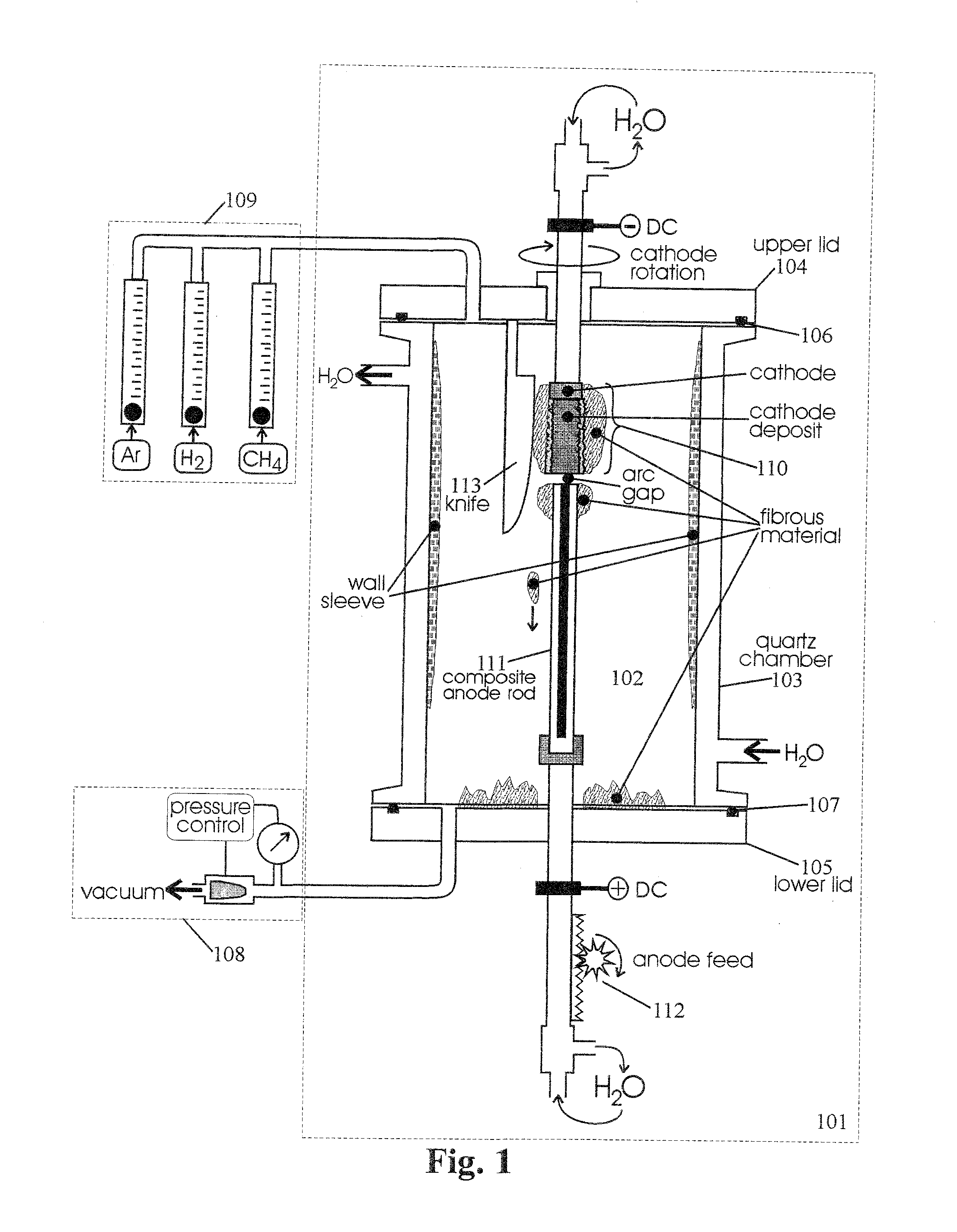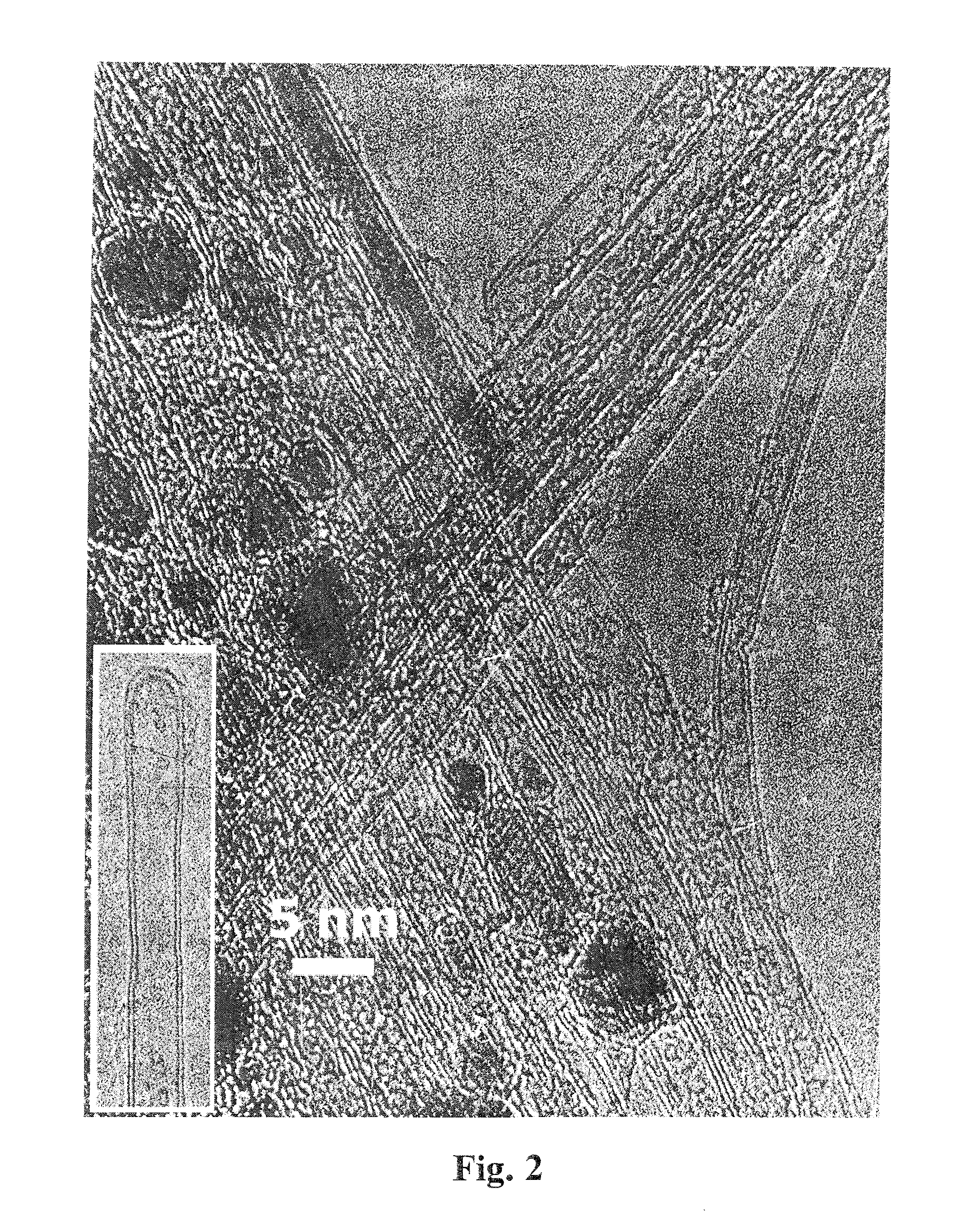Double-walled carbon nanotubes and methods for production and application
a carbon nanotube and double-walled technology, applied in the manufacture of electrode systems, fullerenes, electric discharge tubes/lamps, etc., can solve the problems of large number of layers, difficult control of the number of layers, and the electronic properties and applications of nanotubes are not less attractiv
- Summary
- Abstract
- Description
- Claims
- Application Information
AI Technical Summary
Benefits of technology
Problems solved by technology
Method used
Image
Examples
example 1
[0084]This example presents optimized conditions for high yield of DWNTs.
[0085]Preparation of the catalyst. The mixture of fine metal powders of iron (81.0 g, 2-5 μm particle size), cobalt (41.3 g, 2-5 μm), nickel (152.6 g, 2-5 μm) and elementary sulfur (24.1 g) is heated to 750° C. at a rate 30° C. / min and maintained at this temperature for 30 min in the flow of H2 (20 sccm) and He (30 sccm) at atmospheric pressure in a quartz tube 80 mm in diameter, then cooled down to room temperature. The resultant strong crisp lump of greenish-brown color is ground in a ball mill to a powder with particle size ca. 1-2 μm. This powder is mixed with 75.0 g of fine graphite powder (SUPERIOR GRAPHITE, BG-34).
[0086]Preparation of consumable anode. A graphite rod 210 mm long, 7.93 mm in diameter and of 1.78 g / cm3 density is drilled to 200 mm depth along the axis with a drill 3.18 mm in diameter, and the resultant hole is densely packed with 5.5 g of the catalyst prepared as described above. The calcu...
example 2
[0094]This example demonstrates the negative effect of deviation from he optimal value of the total pressure on the yield and quality of DWNTs.
[0095]The catalyst and experimental conditions are the same as in EXAMPLE 1, except that total gas pressure in the chamber was maintained equal to 700 Torr during the process.
[0096]As a result, the yield of fibrous material has dropped down to 0.18 g (ca. 1.0% of consumed anode). These fibers are weak and easily disintegrate into a powder by crinkling in fingers. The content of DWNTs and SWNTs in the fibrous material is about 5%, the rest is mainly amorphous carbon and metal nanoparticles. The ration DWNTs / SWNTs in the fibrous material is about 1. The wall sleeve is very loose and powdery. It contains about 1% of carbon nanotubes, DWNTs and SWNTs.
example 3
[0097]This example demonstrates the negative effect of deviation from the optimal value of electric current on the yield and selectivity of DWNT production.
[0098]Conditions are the same as in EXAMPLE 1, except that electric current value was maintained equal to 75 A.
[0099]As a result, the yield of fibrous material is 0.65 g (ca. 3.5% of consumed anode). The total yield of DWNTs and SWNTs in the fibrous material is about 60%, the rest is amorphous carbon and metal nanoparticles (FIG. 6). The amount of DWNTs and SWNTs is about equal in the sample of the fibrous material. The same is observed in the wall sleeve material, the ration DWNTs / SWNTs is about 1.
PUM
| Property | Measurement | Unit |
|---|---|---|
| pressure | aaaaa | aaaaa |
| inner diameter | aaaaa | aaaaa |
| inner diameter | aaaaa | aaaaa |
Abstract
Description
Claims
Application Information
 Login to View More
Login to View More - R&D
- Intellectual Property
- Life Sciences
- Materials
- Tech Scout
- Unparalleled Data Quality
- Higher Quality Content
- 60% Fewer Hallucinations
Browse by: Latest US Patents, China's latest patents, Technical Efficacy Thesaurus, Application Domain, Technology Topic, Popular Technical Reports.
© 2025 PatSnap. All rights reserved.Legal|Privacy policy|Modern Slavery Act Transparency Statement|Sitemap|About US| Contact US: help@patsnap.com



